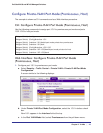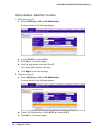
Chapter 3. LAG s | 54
3
3. LAGs
Link Aggregation Groups
This chapter provides the following examples:
• Create Two LAGs on page 55
• Add Ports to LAGs on page 56
• Enable Both LAGs on page 59
Link aggregation allows the switch to treat multiple physical links between two endpoints as a
single logical link.
All the physical links in a given LAG must operate in full-duplex mode at the
same speed. LAGs can be used to directly connect two switches when the traffic between them
requires high bandwidth and reliability, or to provide a higher-bandwidth connection to a public
network. Management functions treat a LAG as if it were a single physical port. You can include
a LAG in a VLAN. You can configure more than one LAG for a given switch.
Server
Subnet 3
Port 1/0/3
LAG_10
Port 1/0/2
LAG_10
Layer 3 Switch
Layer 2 Switch
Subnet 2 Subnet 3
Port 1/0/9
LAG_20
Port 1/0/8
LAG 20
Figure 6. Example network with two LAGs
LAGs offer the following benefits:
• Increased reliability and availability
. If one of the physical links in the LAG goes down,
traffic is dynamically and transparently reassigned to one of the other physical links.


















